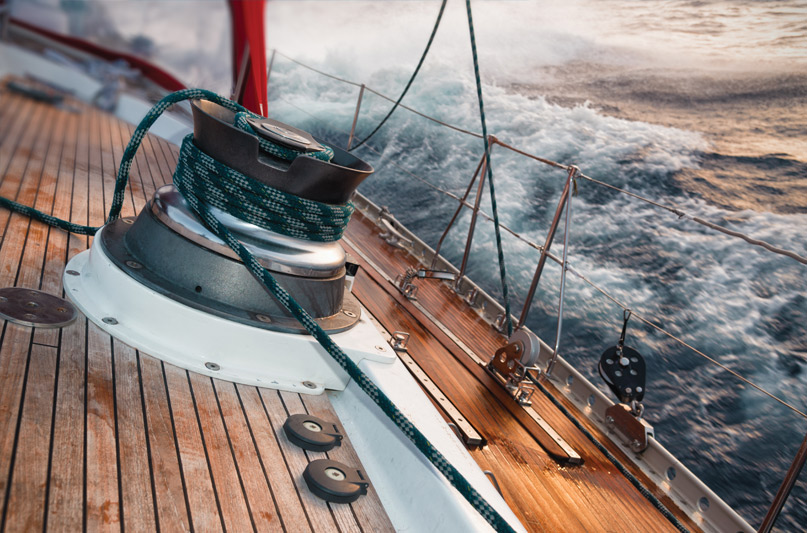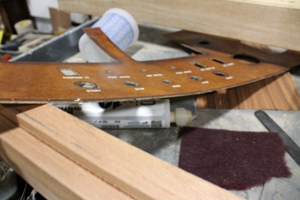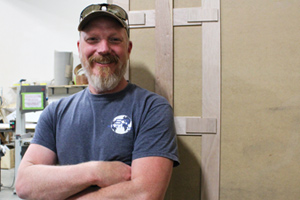
“Ultimately, literature is nothing but carpentry. With both you are working with reality, a material just as hard as wood.”
—Gabiel Garcia Marquez
A boat without at least some wood trim just doesn’t feel like a boat. No matter how futuristic yacht design becomes, it’s a safe bet that wood paneling, furniture, and cabinetry will continue to dominate the interiors. Simultaneously invoking warmth and elegance, homeliness and luxury, well-crafted wood somehow reconciles opposites effortlessly. When we talk about exteriors, a teak deck will always be charismatic, even if the upkeep scares off the average owner.
Local companies like Raptor Deck are not replicating the look with their soft foam paneling for no reason; boaters want the aesthetic.
The perseverance of wood aboard has another secret benefit to society. Thanks to our love of lumber, the art form of maritime woodworking can persevere. The modern maritime woodworker may have access to more knowledge, tools, and training than their predecessors, but the fundamentals are very much unchanged. This admittedly rare but working breed of craftsmen congregate around Pacific Northwest shipyards as subcontractors or under full time employ, bringing their rare talents to bear on new boats during commission or when old boats need some skilled attention.
We sat down with Dennis Simmons, lead carpenter of Seattle-based S3 Maritime, to learn a thing or two about woodworking and the trade. A Portland, Oregon, native, Simmons has been a woodworker his whole life and is a successful and proud alum of the Seattle Central Community College School of Woodworking.
NWY: For starters, is marine woodworking a niche within the woodworking world, or does woodworking in general cross over?
Marine is definitely a niche. It’s a very specialized field of woodworking. Residential is easy in comparison because in marine every project is pretty much custom, meaning it has to be templated. You must match the interior with the pre-made boat build exactly. It’s not like a house remodel where you can change the structure either, with a boat you’re working with the build as it comes from the factory. Also, the little details have to be flawless. With marine, any sloppy work is immediately obvious. The best compliment I can receive is when somebody asks, “What did you even do?” In other words, they don’t even notice all the work I did because it’s perfectly done.
NWY: What are the majority of woodworking projects you work on here at S3 Maritime?
I’d say the majority of what I do has to do with veneering projects. For example, lots of boats leak and the wood rots, so you replace the original paneling with veneer. There’s lots of advantages of veneer over hardwood options. You usually have more options to match the color, grain, etc. of what you need, important for interiors.
With veneer work, a lot of it has to do with matching grains and colors. The main aspect of any sort of remodel is that certain woods patinate, darken over time, or fade with the sun exposure. Teak, for example, fades. Teak starts as this beautiful brown and fades into, like, four different colors before turning into a not-so-pleasant yellow color. If you get an older boat and you’re replacing veneers or on-board furniture, you want to replicate that classic faded look. I often go down to Tacoma, where I buy the veneers, to search for something that’s going to work and not stand out. A lot of it is going through the flitches (samples) to find a light-colored teak with similar characteristics.
NWY: What about the solid lumber approach?
Solid lumber is the alternative to veneer, but almost all boat interiors and detailing is veneer for pragmatic reasons. A factory will buy a couple logs and slice all the veneers for a repeated consistent look for the same boat. Ninety percent of what’s on all boats wood-wise is veneer plywood panels, the walls included, while the solid wood components aboard will usually be the trimming, sea rails, fiddles, door jams, and such. Most of it is veneer.
NWY: It sounds like you need an eye for design with this job too?
You do. For me, it’s artistic because you take the owner’s ideas and you try to blend it in with the aspects of the factory. You’re also educating the owner about why he or she may not want to use this kind of wood or grain pattern and let them know that certain types you can’t quite match perfectly or that others will fade differently then they might think.
NWY: A boat owner can take the look a lot of different ways when consulting with you, from opting for walnut to cherry. What are some of the trends you’re noticing with yachts and their woodwork?
A lot of the yachts are going for that more modern look with squared edges, kind of like what’s on land with the modern hard lines for residential buildings. It’s coming onto the boat, but everything is circular. Now it’s going to vertical grain, hardened square edges, lighter woods. But in ten years I bet it’ll circle around to more traditional designs. There’s a life cycle with trends.
NWY: Is there a family of wood types that are best for marine carpentry?
In the marine world, you’re dealing with a select handful of woods. Teak is the main wood because of its high oil content, so your decks will be made of teak. On custom luxury yachts, teak is the soup de jour. For spec boats, you’ll see some teak too.
The selection widens a bit with interiors, and you often see both teak and woods like American cherry. Maple interiors were more common back in the ’70s and ’80s. On the exterior, everything is teak due to that high oil content.
NWY: You hear sometimes about a teak shortage. Is there a teak shortage? Is teak harder to find?
Well, it’s not that there is a shortage, but that it is all farm raised now. Well, it’s not all farm raised, but we’re decimating our resources as a species in just about every way, so now we need to raise teak on farms to meet demand. The big tsunami back in 2004 wiped out a lot of teak farms and some of them are still recovering.
One note about farm-raised teak is that generally they harvest the wood when the trees are quite young. Younger trees have a lower oil content and the color isn’t usually quite there, appearing quite splotchy with dark brown streaks and orange. It can be rather unattractive. But wild, old-growth teak is in short supply, so that’s just the world we’ve created for ourselves.
Q: NWY: Why don’t you see other woods with great anti-rot properties, like cedar, more often?
I’m not a shipwright, but a lot of cedar was used on older boats, especially yellow cedar for planking. A lot of Alaskan cedar too. A lot of older trawler-style boats will have red or yellow cedar on the interior as well and can be beautiful. One of the drawbacks of cedar is that it is super soft, so if you look at it, it will dent.
NWY: Do you have any tips for those who may be playing with veneer in their own personal lives?
Yes, do not use contact cement. A lot of people use contact cement to keep veneered wall panels down and it just doesn’t work. Wood always moves, I don’t care if it’s dead, it is alive in a sense and will always move. It needs to be locked down, while contact cement is a rubber-like glue that has too much give that lets the wood move around. A lot of people experimented with it and it doesn’t work.
Also, patience is important. Infinite amounts of patience.
NWY: What are some giveaways for poor woodworking craftsmanship on a boat?
You look at the joinery and how tight the seams are. There is zero tolerance for sloppy joinery in maritime, everything has to be flawless. In residential carpentry, you get away with a lot more with regards to joinery. In marine, it challenges you. It has to be perfect in weird places or it will be obvious.
Templating is key, also having spare wood to play with. I build mockups out of off-the-shelf quarter-inch foam poster boards from any arts supply store. People are generally very visual, and many want to see the pieces in the space. I’ll actually build a full-sized mockup of the dash or furniture so the owners can see it and give the concept a thumbs-up or thumbs-down. I use that a lot of times as a template, take it off the boat and up to the shop, and build it.
NWY: Would you recommend that mock-up technique for the do-it- yourselfers?
Certainly! It’s just cutting foam board with a box cutter and hot glue. I learned that from my years as a furniture builder. I had an instance where clients used my foam board furniture as functional furniture until the wood versions were ready, ha!
NWY: Do you have any tips for folks wanting to beef up their woodworking knowledge?
Use the right tools. A lot of times you have to use designated woodworking tools. It’s hard to get good quality pieces with just a skill saw and little ban saw. You usually need a good-sized table saw and sharp tools with sharp edges.
NWY: Any words of wisdom to the next generation of maritime tradespeople out there?
Yes, I highly recommend Seattle Central Community College. I went to their program for furniture building and there are a lot of woodworkers around here from their programs. They have carpentry, furniture, and boat building, two-year programs. I went through furniture and you’re there full time; it’s a big commitment but I highly recommend it. It’s a good program and you get leads for jobs. The industry needs young talent. If you’re interested, take the leap! I love it and have never tired of it.

